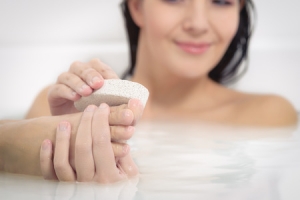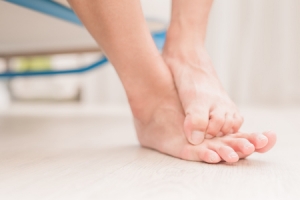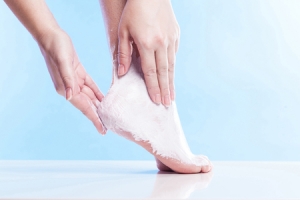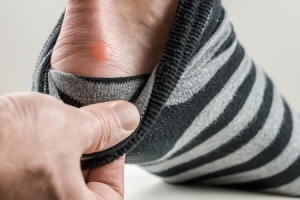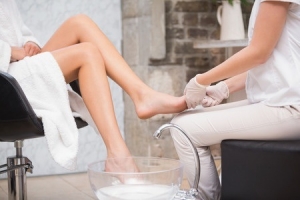Connect With Us
Blogs
Displaying items by tag: fungal infections
Focus on Diabetic Foot Care
At Superior Foot & Ankle Care Center we treat many patients with diabetes. November is American Diabetes Month and a good opportunity for us to go over some care tactics for patients with this disease. Below are some key areas to focus on:
Your Daily Care Routine
Of course, a good foot care regimen is important for everyone, but for a diabetic patient, it is even more critical. Your daily care plan should include:
- Washing your feet with warm water and a mild soap
- Drying your feet completely, with extra care to ensure that the area between your toes is completely dry (this will help prevent fungal infections)
- Checking toenails for jagged edges. Always trim nails straight across with no rounded edges. Do not cut too short and never cut the corners.
- Inspect your feet from every angle. Look for changes in skin and nail color, rashes, flaking skin, bruises, swelling, any scratches or cuts. Report anything that concerns you to our podiatrists, Dr. Victoria Foley and Dr. Constance Omelas to evaluate. It’s always better to be over cautious!
Your Shoes and Socks
Shoes should have wide, roomy toe boxes and be made of soft, flexible materials. Avoid heels higher than 2 inches. When buying new shoes, have your foot professionally measured. Run your hand around the inside of the shoe to make sure there are no rough spots or loose stitching. Wear new shoes for only a few hours at a time and examine your feet after wearing to make sure there are no red spots or blisters forming.
Socks should be the type that wick moisture away from your feet. If you sweat excessively, change your socks multiple times throughout the day. Avoid socks that have overly tight elastic on the tops and those with seams across the toes.
Your Lifestyle Choices
Eating an appropriate diet to help manage your blood sugar is essential. A regular exercise routine will help you maintain a good weight and also improve circulation. Don’t smoke because it has a negative impact on circulation. Follow all of your doctor’s recommendations for keeping your diabetes under control.
If you have questions or concerns about diabetes and your feet, contact our Long Beach office today by calling: (562) 420-9800.
5 Ways to Take Better Care of Your Feet
At Superior Foot & Ankle Care Center we believe in being proactive when it comes to the health of your feet. In honor of Foot Health Awareness Month, we’d like to offer the following tips for taking care of your feet:
- Wear shoes that fit. This is one of, if not the single biggest steps you can take to prevent foot and ankle injuries and disorders. Some studies have shown that up to 90% of people are wearing shoes that are the wrong size! Shoes that are too narrow or tight in the toe box can encourage deformities such as bunions and hammertoes as well as increase the risk of ingrown toenails and fungal infections. Get your foot professionally measured at the shoe store. Shoe size can change as you age and during pregnancy.
- Get in the habit of doing self-exams on your feet. Changes in the skin or nails of your feet, as well as shape, size or color, can all be indicators of potential foot problems. Any differences in sensation (burning, numbness, tingling), swelling or abnormal growths should be reported to our podiatrists, Dr. Victoria Foley and Dr. Constance Omelas promptly. Early detection of a foot problem can mean a better outcome and less invasive treatment.
- Limit time going barefoot. Bare feet in public places are at a higher risk for coming in direct contact with fungi and bacteria that cause infections such as athlete’s foot and fungal toenails. Even at home, however, going barefoot increases your risk of puncture wounds and injuries.
- Don’t neglect foot hygiene. Basic daily care of your feet should include washing with soap and water (and drying completely) as well as applying foot powder or moisturizing lotion, depending on your individual needs. Don’t wear socks more than one day and alternate our shoe choice as well.
- Live a Healthy Lifestyle. You may not think about it but maintaining a healthy weight, exercising and getting regular checkups all contribute to the health and well being of your feet. Be sure that you monitor chronic diseases such as diabetes and arthritis and follow your physicians’ instructions for keeping this conditions under control.
If you have questions about how to best care for your feet, contact our Long Beach office by calling: (562) 420-9800.
3 Foot Care Tips for Getting in Shape
If you are like many of our patients at Superior Foot & Ankle Care Center the New Year is a time to renew your commitment to getting physically fit. This is a worthy resolution that will benefit your feet and your entire body. Improved circulation, maintaining a healthy weight, decreased risk of heart disease and high blood pressure and stress relief are among the many benefits of regular exercise. Before you get started, however, we’d like to make the following suggestions to protect your feet and increase the enjoyment of your fitness program.
Get a Checkup—it’s a good idea to meet with our podiatrists, Dr. Victoria Foley and Dr. Constance Omelas and discuss your fitness goals and how you hope to achieve them. Some exercises put more stress on your feet than others. It’s important to have a complete examination of your feet and ankles and to have the foot doctor address any ongoing problems that you may be having. Sometimes special orthotics or padding may be recommended to protect a vulnerable area and make exercise more comfortable. The foot doctor can also make specific recommendations regarding shoes that suit your gait and foot.
Shop for Shoes—if you are going to be trying out a new activity go to a professional sports shoe store to get the correct footwear for your sport. Sports shoes are designed specifically for the types of movement required for specific activities. You should have your foot measured and also let the shoe salesperson know about any foot issues you have. You can avoid blisters by wearing shoes that are the correct size and don’t rub anywhere on your foot. Be sure to pick up some absorbent socks as well. Keeping feet dry is essential to avoid athlete’s foot and other fungal infections from developing.
Don’t Skip the Conditioning—properly warming up and stretching the ligaments, tendons and muscles in your lower legs and feet before and after exercise can help you avoid common injuries such as shin splints, Achilles tendonitis and plantar fasciitis.
If after you begin an exercise routine you notice pain in your toes, feet, ankles, calves or shins, be sure to make an appointment at our Long Beach office by calling: 562-420-9800. Continuing to work out while you are in pain will cause way more harm than good.
6 Ways to Prevent Diabetic Foot Complications
Here at Superior Foot & Ankle Care Center we believe in the importance of good foot care for all or our patients. For those with diabetes, however, extra precautions are necessary. Diabetes has several conditions associated with it that can result in major medical complications being caused by what other patients may deem minor foot issues. A compromised immune system, reduced circulation and neuropathy (or lack of sensation) all require additional measures to keep feet safe and healthy. Below are 6 podiatric tips for patients with diabetes:
- Choose footwear carefully. Shoes should have roomy toe boxes that don’t cramp or squeeze toes together. This will reduce the risk of ingrown toenails. Shoes should be made of natural, breathable materials. Inspect shoes periodically to make sure there are no rough spots, loose stitching or other elements that could rub on the skin and cause a blister or ulcer.
- Watch the heat. Don’t expose feet to high temperatures from fire places or electric blankets. Carefully monitor water temperature in baths and showers. A loss of sensation can result in burns due to the fact that the patient does not perceive pain from heat or burning.
- Stay dry. Fungi love moist, dark places to grow, such as the inside of sweaty socks. Change socks as soon as you notice they are damp to help avoid fungal infections.
- Keep the blood flowing. You can help improve circulation by exercising regularly and not sitting or standing in one position for long periods of time. Don’t cross your legs or wear socks that are tight or have elastic in the top to hold them up.
- Inspect feet daily. Wash your feet in warm soapy water every day and while you do so, check for cuts, blisters, bumps, bruising, swelling, growths or anything unusual or different on your feet. Report any changes to the foot doctor promptly.
- Make your podiatrist a care partner. Regular podiatric checkups with our podiatrists, Victoria M. Foley and Dr. Constance Ornelas can go a long way toward prevent footing health problems. If seen regularly, the foot doctor can detect changes and potential issues in your feet in the very earliest stages and stop problems before they start.
If you are a patient with diabetes and you have questions about the health of your feet, contact our Long Beach office by calling: 562-420-9800.
Give Your Feet a Gift this Holiday
Tis’ the season for shopping, baking, mailing and attending festive gatherings. And who is it that enables you to enjoy all the merry making of the holiday season? It’s your feet! At Superior Foot & Ankle Care Center we’d like to suggest some great gift ideas for those two very helpful parts of your body.
Moisture Wicking Socks—if you’re a sports enthusiast or just someone who’s on the go all the time these socks will whisk perspiration away from your feet. They can also be the inner layer of a double pair of socks if a ski vacation or other colder climate trip is part of your holiday plans. Keeping feet dry helps them stay warm and can prevent fungal infections (which love moist, dark places) from developing.
Insulated Water Bottle—you may not see the immediate connection to your feet on this one but drinking plenty of water is one way to prevent edema or swelling of your lower legs, ankles and feet. This means less pain at the end of a long day.
New Pair of Walking or Running Shoes—treat your feet to top quality exercise shoes. Have your foot professionally measured at a store that specializes in fitness footwear. Be sure to tell the shoe salesman about any conditions you have such as plantar fasciitis, flat feet or overpronation. Shoes that fit properly and accommodate any deformities or existing conditions will make exercising much more pleasurable and less likely to cause an injury. An added bonus: if you’re motivated to exercise you’ll have an easier time maintaining a healthy weight—a positive factor in preventing several foot disorders.
Super Emollient Foot Cream—nothing says “thanks” like a foot massage at the end of the day with a rich lotion or cream. Feet will stay moist and supple and unlikely to develop cracks or red, flaky patches.
Podiatric Checkup—if you’ve been putting off a visit to the foot doctor to find the source of a nagging pain, stiffness or something unusual that you’ve noticed on one of your feet this may be the best gift of all. Our podiatrists, Dr. Victoria Foley and Dr. Constance Omelas will not only diagnose any discomfort you’ve been experiencing, they can also help make recommendations for shoes that will best suit your individual foot and the activities you do. To make an appointment, contact our Long Beach office at: 562-420-9800.
Don’t Let Blisters Stop Summer Fun
Blisters are a minor foot problem that can cause a major pain and definitely put a temporary crimp in your summer activities. Blisters occur more frequently in the hot months because they are caused by the friction of your socks or shoes rubbing against your skin. Sweat increases friction and hence, more blisters. At Superior Foot & Ankle Care Center we would like to offer some tips for preventing and treating blisters:
- Keep feet dry. As soon as you notice your feet are damp, change your socks. If you tend to sweat profusely, use a foot powder. In addition to blisters, damp feet can be the perfect breeding ground for fungal and bacterial infections.
- Buy shoes that fit properly. The idea that shoes need a breaking in period is a myth. Shop for new shoes at the end of the day—that’s when feet are most swollen. Also, it’s best to not bring a brand new pair of shoes on vacation where you’ll be doing a lot of walking.
- Pack moleskin for your summer vacation. If you begin to feel a sore spot on your heel or toes, cover with a piece of mole skin and change your shoes as soon as you are able to.
- If a blister does form, do not pop it. Cover with a bandage to prevent further irritation. Your body will naturally reabsorb the fluid.
- Should a blister open on its own, wash it with soap and water only. Then apply a small amount of antibacterial ointment and cover with a bandage. Do not cut or tear the open skin. The risk of infection is greatly increased with the skin being open and exposed.
For the most part, blisters are not a medical threat unless they become infected. In that case, you will notice pus or other drainage and potentially a foul odor coming from this blister. If this occurs or the blister appears to be filled with blood, contact our Venice office at: (562) 420-9800. One of our podiatrists, Dr. Victoria Foley or Dr. Constance Ornelas will need to examine your blister and determine if an infection or other problem has developed.
Summer Checklist for Preventing Children’s Foot Problems
Chances are with the end of the school year your child came home with readings lists and other summer work. At Superior Foot & Ankle Care Center we’d like to add one more list: a checklist for taking care of your child’s feet over the summer months. Summer brings a whole new set of activities and options for children, many of which can lead to foot trouble if the proper precautions are not taken. Here are our top tips for keeping children’s feet healthy this season:
Slather on the Sunscreen—many people forget to apply sunscreen to their feet. The skin on your feet is just as susceptible to the harmful effects of UVB and UVA rays as that on the rest of your body. On beach and pool days you should put sunscreen on the tops and bottoms of your children’s feet and reapply after swimming. If your children are wearing sandals or other open shoes and will be out in the sun shopping or sightseeing you should also put sunscreen on their feet then.
Pack the Flip Flops—summertime is high season for athlete’s foot, fungal toenails and warts, all of which are spread by direct contact with the virus, fungi or bacteria that cause them. If you are spending time at a community pool or local beach make sure your child keeps their feet covered around the pool and in changing areas and bathrooms—these are prime hangouts for fungal infections. Encourage your children not to share shoes, socks, towels or any items that touch someone else’s feet.
Inspect Shoes—be sure that your child is wearing shoes that match the activity they are participating in. While flip flops are good for the pool, they can lead to injury if used for playing whiffle ball or other casual summer sports. Also keep an eye on fit—children’s feet grow fast and time spent squeezed into shoes that are too tight can increase the risk of ingrown toenails and fungal infections.
Keep it Clean—wash your children’s feet at the end of every day with a mild soap and warm water. Be sure to dry completely as well, especially between the toes. Trim toenails straight across with no curved edges. If your child’s feet sweat excessively, consider a foot powder to help keep them dry.
If when caring for your child’s feet you notice anything unusual or concerning, or if your child complains of foot pain, don’t hesitate to contact our podiatrists, Dr. Victoria Foley and Dr. Constance Omelas at our Long Beach office by calling 562-420-9800. It’s always better to get a foot concern checked than to wait and have it develop into a serious issue. Enjoy the summer and keep your children’s feet safe!
Pointers for Safe Pedicures
Who doesn’t like showing off one of the season’s newest colors on their toes? Besides, getting a professional pedicure is a relaxing treat. Bacterial and fungal infections, such as athlete’s foot and fungal toenails, however, are not particularly enticing. At Superior Foot & Ankle Care Center we want our patients to be able to enjoy this pampering experience safely and so we have compiled some tips below to help prevent infections.
First, however, it’s important that you inspect your toenails and make sure that you do not currently have any problems. If you have a toenail that is discolored, thick or crumbly, do not attempt to cover it up with nail polish. These may be signs of a fungal infection that requires treatment. If the appearance of one of your nails is concerning you, contact our Long Beach office by calling: (562) 420-9800 and let our podiatrists, Dr. Victoria M. Foley or Dr. Constance Ornelas examine your toenail. Fungal infections will not go away without treatment.
If your nails are all clear and you wish to have a professional pedicure, observe the suggestions here to minimize any risk of fungal or bacterial infections:
- Bring your own nail tools and flip flops. The ideas is to not come in contact with items that have touched other people’s feet. Fungal toenail and bacterial infections are spread by direct contact.
- Look for a license. Reputable salons are licensed by the state, which means they adhere to specific health and sanitary standards. The license should be prominently displayed in the salon.
- Check out the cleanliness of your salon. Foot baths and tools should be cleaned and disinfected after each customer. Nail technicians should wash their hands before starting on a new client and the floors, work stations and rest room should all be clean.
- Refrain from shaving your legs 24 hours before getting a pedicure. Shaving creates tiny cuts in the skin which can allow bacteria to enter. For this reason, if you have any open cuts or blisters on your toes, feet or legs, you should also wait until they have healed before getting a pedicure.
On the Job Care for Your Feet
Would you believe that the National Safety Council reports that there is an average of 180,000 foot injuries on the job each year? At Superior Foot & Ankle Care Center we want our patients to be proactive about the health of their feet at all times. Most patients spend a large percentage of their waking hours at work yet don’t give much thought to the health and safety of their feet in the workplace setting. Preventive health care for your feet at work falls into two categories: injury and overuse.
Injury
Injury to your feet on the job can come about as a result of the materials you are working with or the site of your work. Construction workers and those who work at sites where there is much debris and loose rock or other material on the ground need properly fitting shoes or work boots to support feet and ankles and minimize the risk of falls and ankle sprains. Another statistic from the National Safety Council showed that of the workers who suffered a job-related foot injury only about 25% were wearing protective footwear. Work boots with hard toe boxes protect against tools and heavy items being dropped on them. If you work with hazardous materials, chemicals or liquids at high temperatures you will want to take the proper precautions to protect your feet as well as the rest of your body.
If you wear work boots every day you may find it beneficial to have a second pair to trade off with to prevent repetitive stress to the same areas of your feet and to minimize the risk of athlete’s foot and other fungal infections that can breed in dark, sweaty boots. A day to air out between airings can reduce this risk significantly.
Overuse
The second source of workplace stress on the feet is overuse. Jobs that require long hours of standing or a significant amount of bending or climbing put stress on your feet. Be sure to take breaks throughout the day and elevate your feet (if you can’t do at work be sure to do when you get home) to reduce swelling. Many conditions are caused or made worse by standing for long periods of time. You will want to take the time to have the shoes you wear for work professionally fitted and be sure they are of high quality and provide good arch support and cushioning where needed.
Our podiatrists, Dr. Victoria Foley and Dr. Constance Omelas can make specific recommendations for appropriate footwear for you based on your foot condition and the work you do. Don’t hesitate to contact us for a consultation with the podiatrist at our Long Beach office by calling: (562) 420-9800. After a hard day’s work, your feet will thank you!

